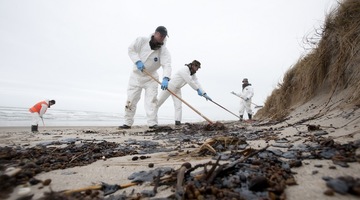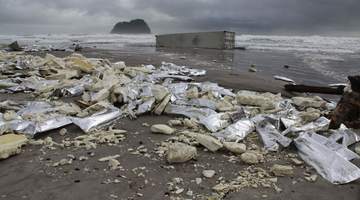Immediately following the grounding of the Rena on the Astrolabe Reef, the Bay of Plenty Polytechnic and the University of Waikato formed a marine response team. This team surveyed local marine life before it was affected by oil. This was done so that later survey comparisons could be made to determine whether the oil had had an effect on marine life.
Transcript
At 2.20 am on the 5th October 2011, the cargo vessel Rena ran aground on Astrolabe reef off the Port of Tauranga. It began to leak oil.
Bay of Plenty Polytechnic and the University of Waikato formed a marine rapid response team to survey the biology of the local reefs.
It is vital to establish baseline reef health before any oil affects the marine life. You need to know the health of the marine life before the oil reaches it to be able to make comparisons to observations made at a later date. This will help determine whether the oil has had an effect on marine life.
Dive sites are selected for the surveying, and the scientists prepare for the first dive. Drysuits worn over their clothes will keep them warm and dry in the cold water. In addition to the usual diving equipment, the divers also need equipment for the surveying. Notes are written underwater with pencils on special waterproof paper attached to their dive slates. They use quadrats (or sampling squares) and cameras to record the different habitats. A blue and white dive flag marks the site.
At specified depths, the scientists take photos of the plants and animals inside the bright orange quadrats. They record the size and abundance of key species, such as sea urchins and kelp. At each depth within a site, five repeat photos are taken to measure the variability, and fingers are held up to record the number of the replicate. These ‘before’ photos will later be compared to ‘after’ photos to record any differences. The scientists also use dive computers to measure depth and time elapsed under water. Video transects also provide a useful and rapid record of the variety and components of particular habitats. Samples are collected for analysis, including the lamina of the seaweeds, some large sponges and other colourful invertebrates.
The dive lasts about 45 minutes, and soon it’s back to the boat where the scientists give general descriptions of the site and process the collected samples. This involves labelling them and snap freezing them in dry ice. Then it’s off to the next site.
It is important to sample a wide spread of sites in the Bay of Plenty that might soon be affected by oil from the RenaGPS coordinates are used to locate each of the sites. Dive times and depths are closely monitored for each diver on their computers to make sure the divers are safe to carry on working.
The divers work together as a team to record and identify the key species. At the sites, they see a range of seaweeds, spiky sea urchins, gorgonian fan trees and white-fringed anemones. The seafloor is packed with interesting invertebrate life. More photo quadrats and video are taken, and then it’s back to the boat.
A small brown seaweed is identified before being snap frozen for analysis. It’s important to keep good notes of the sites and what has been found.
Back in the water for the third dive, and they have the company of a curious fur seal. This is a much shallower site, and the waves move the divers around, making it more difficult to count and measure sea life.
The wind has come up so it’s a bumpy ride home, but they are soon in the calm water of Tauranga Harbour. Time to unload all the equipment and catalogue all the photo quadrats and video transects. Back at the lab, the samples will be put in a special minus 80 degree freezer.
With the leaking oil reaching the shore, a clean-up begins – this involves beach clean-up crews and volunteers manually picking up the oil and putting it into plastic bags. Using machines is quicker but pushes the oil deeper into the sand, making it harder to retrieve. The oil from the Rena was also found stuck onto the rocks around Mount Maunganui at high-tide level. It was very sticky, and it was important to use protective gloves, disposable covers on shoes and overalls to stop spreading the oil further. The work was very slow, hot and difficult.
Follow-up underwater surveys are being carried out by divers from the marine rapid response team to establish the impacts of the oil and recovery times for key species.






